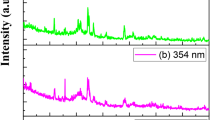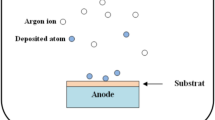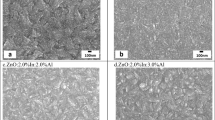Abstract
High quality, ~ 120 nm thin ZnO and Ti-doped ZnO (TZO) films were deposited on silicon substrates using magnetron co-sputtering technique. Surface roughness of the films was ~ 2 nm. Ti incorporation effect on the structure, morphology, conductivity, density of states (DOS) and conduction mechanism was investigated in detail. Ti ions were incorporated in the interstitial sites of hexagonal ZnO lattice. Average crystallite size increased from ~ 16.63 to ~ 19.08 nm upon Ti doping in ZnO film. Conduction mechanism changed from overlapping large polaron tunneling (OLPT) for undoped ZnO film to corelated barrier hopping (CBH) for TZO film. The experimental data were fitted theoretically using OLPT and CBH models to calculate frequency and temperature-dependent DOS. An enhancement of ac conductivity and DOS was observed with the doping of Ti in ZnO thin film. Complex modulus study of TZO film revealed transition from long-range mobility to short-range mobility with increase in frequency.






Similar content being viewed by others
References
S.A. Bidier, M.R. Hashim, A.M. Al-Diabat, M. Bououdina, Effect of growth time on Ti-doped ZnO nanorods prepared by low-temperature chemical bath deposition. Phys. E Low Dimens. Syst. Nanostruct. 88, 169–173 (2017). https://doi.org/10.1016/J.PHYSE.2017.01.009
W. Zhao, Q. Zhou, X. Zhang, X. Wu, A study on Ti-doped ZnO transparent conducting thin films fabricated by pulsed laser deposition. Appl. Surf. Sci. 305, 481–486 (2014). https://doi.org/10.1016/J.APSUSC.2014.03.119
F.-H. Wang, J.-C. Chao, H.-W. Liu, T.-K. Kang, Physical properties of ZnO thin films codoped with titanium and hydrogen prepared by RF magnetron sputtering with different substrate temperatures. J. Nanomater 2015, 1–11 (2015). https://doi.org/10.1155/2015/936482
J.-L. Chung, J.-C. Chen, C.-J. Tseng, The influence of titanium on the properties of zinc oxide films deposited by radio frequency magnetron sputtering. Appl. Surf. Sci. 254, 2615–2620 (2008). https://doi.org/10.1016/J.APSUSC.2007.09.094
M. Wang, Y. Zhang, H. Yu, Q. Li, S.H. Hahn, E.J. Kim, Nanosheet-constructed transparent conducting ZnO:In thin films. J. Alloys Compd. 561, 211–213 (2013). https://doi.org/10.1016/J.JALLCOM.2013.01.181
P. Song, M. Watanabe, M. Kon, A. Mitsui, Y. Shigesato, Electrical and optical properties of gallium-doped zinc oxide films deposited by dc magnetron sputtering. Thin Solid Films 411, 82–86 (2002). https://doi.org/10.1016/S0040-6090(02)00192-X
G. Kim, J. Bang, Y. Kim, S.K. Rout, S.I. Woo, Structural, electrical and optical properties of boron doped ZnO thin films using LSMCD method at room temperature. Appl. Phys. A. 97, 821–828 (2009). https://doi.org/10.1007/s00339-009-5317-9
F.-H. Wang, H.-P. Chang, C.-C. Tseng, C.-C. Huang, Effects of H2 plasma treatment on properties of ZnO:Al thin films prepared by RF magnetron sputtering. Surf. Coat. Technol. 205, 5269–5277 (2011). https://doi.org/10.1016/J.SURFCOAT.2011.05.033
S.-S. Lin, J.-L. Huang, P. Šajgalik, The properties of Ti-doped ZnO films deposited by simultaneous RF and DC magnetron sputtering. Surf. Coat. Technol. 191, 286–292 (2005). https://doi.org/10.1016/J.SURFCOAT.2004.03.021
A. Slassi, N. Lakouari, Y. Ziat, Z. Zarhri, A. Fakhim Lamrani, E.K. Hlil, A. Benyoussef, Ab initio study on the electronic, optical and electrical properties of Ti-, Sn- and Zr-doped ZnO. Solid State Commun. 218, 45–48 (2015). https://doi.org/10.1016/j.ssc.2015.06.010
Y.-M. Lu, C.-M. Chang, S.-I. Tsai, T.-S. Wey, Improving the conductance of ZnO thin films by doping with Ti, Thin Solid Films. 447–448 (2004) 56–60. https://doi.org/10.1016/J.TSF.2003.09.022
Y.R. Park, K.J. Kim, Optical and electrical properties of Ti-doped ZnO films: observation of semiconductor–metal transition. Solid State Commun. 123, 147–150 (2002). https://doi.org/10.1016/S0038-1098(02)00217-X
H. Chen, W. Guo, J. Ding, S. Ma, Ti-incorporated ZnO films synthesized via magnetron sputtering and its optical properties. Superlattices Microstruct. 51, 544–551 (2012). https://doi.org/10.1016/J.SPMI.2012.02.003
Z.-Y. Ye, H.-L. Lu, Y. Geng, Y.-Z. Gu, Z.-Y. Xie, Y. Zhang, Q.-Q. Sun, S.-J. Ding, D.W. Zhang, Structural, electrical, and optical properties of Ti-doped ZnO films fabricated by atomic layer deposition. Nanoscale Res. Lett. 8, 108 (2013). https://doi.org/10.1186/1556-276X-8-108
M. Yilmaz, G. Turgut, Titanium doping effect on the characteristic properties of sol-gel deposited ZnO thin films. Kov. Mater. 53, 333–339 (2015)
S.-S. Lin, J.-L. Huang, D.-F. Lii, Effect of substrate temperature on the properties of Ti-doped ZnO films by simultaneous rf and dc magnetron sputtering. Mater. Chem. Phys. 90, 22–30 (2005). https://doi.org/10.1016/J.MATCHEMPHYS.2004.08.040
J.J. Lu, Y.M. Lu, S.I. Tasi, T.L. Hsiung, H.P. Wang, L.Y. Jang, Conductivity enhancement and semiconductor–metal transition in Ti-doped ZnO films. Opt. Mater. Amst 29, 1548–1552 (2007). https://doi.org/10.1016/J.OPTMAT.2006.08.002
P.S. Shewale, N.K. Lee, S.H. Lee, K.Y. Kang, Y.S. Yu, Ti doped ZnO thin film based UV photodetector: Fabrication and characterization. J. Alloys Compd. 624, 251–257 (2015). https://doi.org/10.1016/J.JALLCOM.2014.10.071
B.D. Cullity, Elements of X-ray Diffraction, 2nd ed., Addison-Wesley, New York 1978
R.D. Gould, A.K. Hassan, A. C. electrical properties of thermally evaporated thin films of copper phthalocyanine. Thin Solid Films 223, 334–340 (1993). https://doi.org/10.1016/0040-6090(93)90541-V
Y. Cherifi, A. Chaouchi, Y. Lorgoilloux, M. Rguiti, A. Kadri, C. Courtois, Electrical, dielectric and photocatalytic properties of Fe-doped ZnO nanomaterials synthesized by sol gel method. Process. Appl. Ceram. 10, 125–135 (2016). https://doi.org/10.2298/PAC1603125C
M.F. Afsar, A. Jamil, M.A. Rafiq, Ferroelectric, dielectric and electrical behavior of two-dimensional lead sulphide nanosheets. Adv. Nat. Sci. Nanosci. Nanotechnol. 8, 045010 (2017). https://doi.org/10.1088/2043-6254/aa8b3d
M. Ahmad, M.A. Rafiq, M.M. Hasan, Transport characteristics and colossal dielectric response of cadmium sulfide nanoparticles. J. Appl. Phys. 114, 133702 (2013). https://doi.org/10.1063/1.4823810
A. K. Jonscher, The “universal” dielectric response, Nature 267 (1977) 673–679
J. Nagaraju, S. B. Krupanidhi, Dc and ac transport properties of Mn-doped ZnO thin films grown by pulsed laser ablation. Mater. Sci. Eng. B. 133, 70–76 (2006). https://doi.org/10.1016/J.MSEB.2006.05.005
A. Tabib, N. Sdiri, H. Elhouichet, M. Férid, Investigations on electrical conductivity and dielectric properties of Na doped ZnO synthesized from sol gel method. J. Alloys Compd. 622, 687–694 (2015). https://doi.org/10.1016/j.jallcom.2014.10.092
M. Krimi, K. Karoui, A. Ben Rhaiem, Electrical and dielectric properties of the Li 1.5Na0.5WO4 compound. J. Alloys Compd. 698, 510–517 (2017). https://doi.org/10.1016/J.JALLCOM.2016.12.237
S. Fareed, A. Jamil, M.A. Rafiq, F. Sher, Zinc modified cadmium titanite nanoparticles: Electrical and room temperature methanol sensing properties. Ceram. Int. 44, 4751–4757 (2018). https://doi.org/10.1016/j.ceramint.2017.12.059
A. Jamil, S.S. Batool, F. Sher, M.A. Rafiq, Determination of density of states, conduction mechanisms and dielectric properties of nickel disulfide nanoparticles. AIP Adv. 6, 055120 (2016). https://doi.org/10.1063/1.4952966
M. Shunmugam, H. Gurusamy, P. Anand, Devarajan, Investigations on the structural, electrical properties and conduction mechanism of CuO nanoflakes. Int. J. Nano Dimens. 8, 216–223 (2017)
S. Karthickprabhu, G. Hirankumar, A. Maheswaran, R.S. Daries Bella, C. Sanjeeviraja, Structural and electrical studies on Zn2+ doped LiCoPO4. J. Electrostat. 72, 181–186 (2014). https://doi.org/10.1016/J.ELSTAT.2014.02.001
M. Ganaie, M. Zulfequar, Ac conductivity measurement of Cd5 Se95—x Znx chalcogenide semiconductor using correlated barrier hopping model. Acta Phys. Pol. A. 128, 59–63 (2015). https://doi.org/10.12693/APhysPolA.128.59
T.M. Meaz, S.M. Attia, A.M. Abo El, Ata, Effect of tetravalent titanium ions substitution on the dielectric properties of Co–Zn ferrites. J. Magn. Magn. Mater. 257, 296–305 (2003). https://doi.org/10.1016/S0304-8853(02)01212-X
A. Ghosh, Ac conduction in iron bismuthate glassy semiconductors. Phys. Rev. B 42, 1388–1393 (1990). https://doi.org/10.1103/PhysRevB.42.1388
I.G. Austin, N.F. Mott, Polarons in crystalline and non-crystalline materials. Adv. Phys. 18, 41–102 (1969). https://doi.org/10.1080/00018736900101267
A. Jamil, M.F. Afsar, F. Sher, M.A. Rafiq, Temperature and composition dependent density of states extracted using overlapping large polaron tunnelling model in MnxCo1 – xFe2O4 (x = 0.25, 0.5, 0.75) nanoparticles. Phys. B Condens. Matter. 509, 76–83 (2017). https://doi.org/10.1016/j.physb.2017.01.005
N. Chakchouk, B. Louati, K. Guidara, Electrical properties and conduction mechanism study by OLPT model of NaZnPO4 compound. Mater. Res. Bull. 99, 52–60 (2018). https://doi.org/10.1016/J.MATERRESBULL.2017.10.046
M. Tan, Y. Köseoǧlu, F. Alan, E. Şentürk, Overlapping large polaron tunneling conductivity and giant dielectric constant in Ni0.5Zn0.5Fe1.5Cr 0.5O4 nanoparticles (NPs). J. Alloys Compd. 509, 9399–9405 (2011). https://doi.org/10.1016/j.jallcom.2011.07.063
R. Punia, R.S. Kundu, M. Dult, S. Murugavel, N. Kishore, Temperature and frequency dependent conductivity of bismuth zinc vanadate semiconducting glassy system. J. Appl. Phys. 112, 083701 (2012). https://doi.org/10.1063/1.4759356
M.M. Abdel-Kader, M.A.F. Basha, G.H. Ramzy, A.I. Aboud, Thermal and ac electrical properties of N-methylanthranilic acid below room temperature. J. Phys. Chem. Solids 117, 13–20 (2018). https://doi.org/10.1016/J.JPCS.2018.02.007
S. Dahiya, R. Punia, S. Murugavel, A.S. Maan, Structural and other physical properties of lithium doped bismuth zinc vanadate semiconducting glassy system. J. Mol. Struct. 1079, 189–193 (2015). https://doi.org/10.1016/j.molstruc.2014.09.047
A.K. Roy, A. Singh, K. Kumari, K. Amar Nath, A. Prasad, K. Prasad, Electrical Properties and AC Conductivity of (Bi0.5Na0.5)0.94Ba0.06TiO3 Ceramic, ISRN Ceram. 2012 (2012) 1–10. https://doi.org/10.5402/2012/854831
K. Lily, K. Kumari, R.N.P. Prasad, Choudhary, Impedance spectroscopy of (Na0.5Bi0.5)(Zr0.25Ti0.75)O3 lead-free ceramic. J. Alloys Compd. 453, 325–331 (2008). https://doi.org/10.1016/j.jallcom.2006.11.081
K. Prasad, K. Lily, K.P. Kumari, K.L. Chandra, S. Yadav, Sen, Electrical properties of a lead-free perovskite ceramic: (Na0.5Sb0.5)TiO3. Appl. Phys. A. 88, 377–383 (2007). https://doi.org/10.1007/s00339-007-3989-6
M.A. Diab, N.A. El-Ghamaz, F.S. Mohamed, E.M. El-Bayoumy, Conducting polymers VIII: Optical and electrical conductivity of poly(bis-m-phenylenediaminosulphoxide). Polym. Test. 63, 440–447 (2017). https://doi.org/10.1016/J.POLYMERTESTING.2017.09.001
S. Thakur, R. Rai, I. Bdikin, M.A. Valente, Impedance and modulus spectroscopy characterization of Tb modified Bi0.8 A0.1 Pb0.1 Fe0.9 Ti0.1 O3 ceramics. Mater. Res. 19, 1–8 (2016). https://doi.org/10.1142/S0219720012030011
M. Coskun, O. Polat, F.M. Coskun, Z. Durmus, M. Çaglar, A. Turut, The electrical modulus and other dielectric properties by the impedance spectroscopy of LaCrO3 and LaCr0.90Ir0.10O3 perovskites. RSC Adv. 8, 4634 (2018). https://doi.org/10.1039/C7RA13261A
Z. Imran, M.A. Rafiq, M. Ahmad, K. Rasool, S.S. Batool, M.M. Hasan, Temperature dependent transport and dielectric properties of cadmium titanate nanofiber mats. AIP Adv. 3, 032146 (2013). https://doi.org/10.1063/1.4799756
M.H. Lakhdar, T. Larbi, B. Khalfallah, B. Ouni, M. Amlouk, Structural, dielectric and a.c. conductivity study of Sb2O3 thin film obtained by thermal oxidation of Sb2S3. Bull. Mater. Sci. 39, 1801–1808 (2016). https://doi.org/10.1007/s12034-016-1335-3
R. Ben Belgacem, M. Chaari, A.F. Braña, B.J. Garcia, A. Matoussi, Structural, electric modulus and complex impedance analysis of ZnO/TiO 2 composite ceramics. J. Am. Ceram. Soc. 100, 2045–2058 (2017). https://doi.org/10.1111/jace.14725
M. Chaari, R. Ben Belgacem, A. Matoussi, Impedance analysis, dielectric relaxation and modulus behaviour of ZnO-Sn 2 O 3 ceramics. J. Alloys Compd. 726, 49–56 (2017). https://doi.org/10.1016/j.jallcom.2017.07.295
M. Coşkun, Ö Polat, F.M. Coşkun, Z. Durmuş, M. Çağlar, A. Türüt, The electrical modulus and other dielectric properties by the impedance spectroscopy of LaCrO 3 and LaCr 0.90 Ir 0.10 O 3 perovskites. RSC Adv 8, 4634–4648 (2018). https://doi.org/10.1039/C7RA13261A
M. Azizar Rahman, A.K.M. Akther, Hossain, Electrical transport properties of Mn–Ni–Zn ferrite using complex impedance spectroscopy. Phys. Scr. 89, 025803 (2014). https://doi.org/10.1088/0031-8949/89/02/025803
Y. Ben Taher, N. Moutia, A. Oueslati, M. Gargouri, Electrical properties, conduction mechanism and modulus of diphosphate compounds. RSC Adv. 6, 39750–39757 (2016). https://doi.org/10.1039/C6RA05220G
Acknowledgements
M. A. Rafiq would like to acknowledge Higher Education Commission for financial support under National Research Program for Universities (NRPU Project No 3662). M. A. Rafiq would also like to acknowledge the financial support from Chinese Academy of Sciences Presidents’s International fellowship initiative grant No 2018VTA0002. A. Jamil would like to thank Higher Education Commission for financial support through IRSIP.
Author information
Authors and Affiliations
Corresponding author
Additional information
Publisher’s Note
Springer Nature remains neutral with regard to jurisdictional claims in published maps and institutional affiliations.
Rights and permissions
About this article
Cite this article
Jamil, A., Fareed, S., Tiwari, N. et al. Effect of titanium doping on conductivity, density of states and conduction mechanism in ZnO thin film. Appl. Phys. A 125, 238 (2019). https://doi.org/10.1007/s00339-019-2544-6
Received:
Accepted:
Published:
DOI: https://doi.org/10.1007/s00339-019-2544-6




